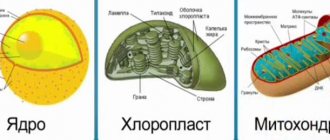Lesson plans on technology (girls) 8th grade technology lesson plan (8th grade) on the topic
Lesson Plan #3
Topic: Types of poultry. Poultry dishes.
Lesson objectives:
- introduce the types of poultry and the primary processing of poultry;
- teach how to perform primary poultry processing;
- cultivate friendly relationships in the team and work culture;
- develop students' creative thinking and ability to work in groups.
Lesson type: combined.
During the classes.
- Organizational moment (3-5 min.)
- Checking readiness for the lesson.
- Checking the payroll.
- State the topic and purpose of the lesson.
- Check execution of d/z.
- Repetition of the covered material (3-5 min.)
- What is the calorie content of food?
- What calorie groups are food products divided into?
- In what units is the calorie content of food measured?
- Explanation of new material (20-25 min.)
Meat is one of the most ancient human foods. Our primitive ancestors ate it raw, and, having learned to make and store fire, they began to fry it. Over time, man began to domesticate animals and then breed them.
In the tribal society, many beliefs and rituals were associated with animals. Each clan had its own totem - a species of animal or plant supposedly related to a given group of people. It was forbidden to harm a totem animal or plant and eat it. Totemism was widespread among all peoples of the world. Its remnants have been preserved in almost all religions, and are reflected in many legends. Here's one of them.
When night fell over ancient India and the stars covered the sky with a silver net, a piercing scream was heard over the country. It was the sacred sun birds screaming. They warned people that midnight was coming and evil spirits, having conquered the sun, were roaming the earth. But by morning the same ringing cry of “ku-ka-re-ku” rang out again - now it announced that the evil spirits were leaving and morning was coming.
Unknown travelers entered this country and took wonderful birds to China. Two and a half thousand years ago, soldiers from Persia went to India. When the army of King Darius returned from the campaign, the soldiers took with them rich booty: diamonds, fabrics, paints, spices. They also brought very beautiful sunbirds: with a golden chest, a red back like fire, and a long black-green tail curved like a sickle. These were the wild ancestors of roosters. Travelers and warriors also brought chickens with them.
Naturalists visited the forests of India, the foothills of the Himalayas and the islands of the Malay Archipelago, where wild chickens live, and learned that they live mainly in bushes and bamboo thickets, easily fly from tree to tree, and make nests on the ground. We learned that wild chickens are brown, yellow, and motley; there were even white wild roosters and completely black hens.
In Persia they seriously believed the Indian fairy tale that sunbirds warn people against evil spirits at night. And there an order was issued to keep roosters in every house. Moreover, it was strictly forbidden to kill them. Meanwhile, sunbirds began to appear in other countries. Two thousand years ago they were brought to settlements and cities on the Black Sea coast - to Kerch, Kherson, near Sevastopol.
Soon chickens began to cluck and roosters began to crow all over Rus', turning from an untouchable fairy-tale bird... into a food product. They have spread widely in European countries, and in other places they have become the cheapest and most accessible meat product for everyone.
By the 18th century, chickens had become widespread in European countries, and in other places they became the cheapest and most accessible meat product for everyone.
This was the case in Corsica. The island was literally swarming with chickens. In poor families, they were most often simply boiled - thus, they got both soup and boiled meat for the main course.
It is said that after eating poultry almost daily for three decades (both as a child and during his military service), Napoleon eventually acquired a strong aversion to it and, when he became consul and then emperor, ordered his cooks to never, under any circumstances, did they dare serve him chicken. Those who disobeyed faced the guillotine. Everyone religiously complied with Napoleon's demands.
Until Lagupierre became his cook. He was a virtuoso of the culinary arts, not accustomed to being interfered with in his culinary plans and inventions. He silently listened to the emperor’s order and the next day served him for lunch... chicken, and in no way, outwardly disguised. Napoleon was beside himself with rage.
Summoned to explain, Lagupierre calmly told the emperor that the latter was free to execute him, but let him first try at least a piece of the dish. If you don’t like it, then Lagupierre is ready to part with his head. Surprised, Napoleon, out of curiosity, tried the cook's dish and was amazed that it did not have the specific smell and taste of chicken meat, which irritated him so much.
Since then, Lagupierre received permission to include chicken meat in the imperial menu and each time he prepared the bird so that its taste was different.
This story is instructive. After all, any food becomes boring, including meat, if you cook the same thing from it. A skilled cook can always prepare many dishes that are not similar in taste from one type of meat.
Poultry dishes, especially chickens and turkeys, are easily digestible by the human body. They are of great importance in the nutrition of not only adults, but also children and the sick.
Poultry meat contains more complete proteins than the meat of large and small livestock, it has less connective tissue, and its fat has a lower melting point.
Poultry is supplied to public catering establishments mainly cooled, chilled or frozen in plucked form. The bird can be ungutted, semi-gutted or gutted.
A semi-gutted bird carcass should not contain intestines, and a gutted bird should not contain internal organs (except for the lungs, kidneys and omentum), head, legs and wings. The head is removed up to the 2nd cervical vertebra inclusive, the legs are removed up to the heel joint, and the wings are removed up to the elbow joint.
Based on fatness and quality of processing, poultry is divided into categories I and II.
Poultry carcasses that have been frozen twice or have changed color, regardless of fatness and quality of processing, are not allowed for sale in public catering establishments and are used for industrial processing.
Game meat has a special taste: it has a bitter but pleasant taste and contains substances that stimulate the appetite.
Game: wood grouse (black, grey), hazel grouse, partridge (white, grey), black grouse and pheasants.
Primary processing of poultry.
Primary processing of poultry and game consists of the following operations: thawing (if the bird is frozen), plucking, singeing, gutting, washing, shaping (dressing) and preparing semi-finished products.
Thawing. Frozen poultry and game are thawed in a storage chamber at a temperature of 3 to 6° or directly in the workshop at 15–20°.
Plucking. The feathers of thawed carcasses are plucked, starting from the neck. In order not to damage the skin, it should be stretched with the fingers of your left hand in the place where the feathers are pulled out. Pluck the carcass with quick movements of the hands, pulling out several feathers at once in the direction opposite to their natural growth. Poultry is plucked immediately after slaughter, since the feathers of a cooled bird are difficult to pull out and the skin may tear. To speed up and facilitate plucking a freshly killed bird, immerse it in hot water (70-80°) for one minute.
Searing. Poultry and some types of game are singed to remove small hairs and feathers remaining after plucking the carcass. A scalded bird is not singed. Before singeing, the carcasses are straightened so that there are no folds of skin on them. To do this, the wings should be unfolded and, holding the carcass by the head with one hand and the legs with the other hand, stretch it a little and scorch it on a non-smoking flame of a gas or alcohol burner.
Preparation of semi-finished products.
Cutlet mass. Cutlet mass is most often prepared from the meat of chickens, turkeys, hazel grouse, black grouse, partridges, wood grouse and pheasants.
When making cutlet mass from poultry carcasses, fillet and leg pulp are used, and from game carcasses (except pheasant and partridge) - only fillet. Pheasant and partridge legs can also be used to prepare cutlet mass, as they do not have a bitter aftertaste. Remove the skin from the fillet and leg flesh and separate the meat from the bones.
The prepared meat is passed through a meat grinder twice, combined with stale wheat bread made from flour of at least 1st grade, previously soaked in milk (the crust is cut off from the bread and soaked in milk 15 minutes before use), salted and mixed thoroughly.
In addition to bread and salt, ground hot pepper is added to the game cutlet mass. Then the cutlet mass is again passed through a meat grinder, butter is added to it, which is kneaded well before this, and everything is thoroughly mixed again.
For 1 kg of meat, take 250 g of wheat bread, 320-350 g of milk or cream, 30 g of butter, 20 g of salt, 0.1 g of ground pepper (the latter is only added to the game cutlet mass).
Cutlets and balls are formed from the cutlet mass.
Semi-finished products are placed on wooden trays or metal tinned baking sheets, sprinkled with ground breadcrumbs, and before heat treatment they are stored at a temperature of 0 to 5° in refrigerators, refrigerators or on ice for no more than 24 hours.
- Practical work “Primary processing of poultry” (40-45 min.)
Current briefing.
Preparation of semi-finished products (cutlet mass).
- Fixing the material. Summing up the lesson. Reflection (5-7 min.)
- What is the importance of poultry meat in nutrition?
- List the types of birds?
- What does primary poultry processing include?
- Assortment of poultry dishes.
Grading. Lesson analysis.
- Homework (2-3min.)
Working clothes and products for etc. Write 3 recipes for poultry dishes.
Lesson on technology “Culture at home”
Lesson plan on technology in 8th grade. Date: 04/28/2015
Lesson when studying the section “Culture at home”
Lesson topic:
Home improvement.
Color selection.
Target:
developing the ability to use colors when decorating an apartment space to create a harmonious environment.
Tasks:
- Introduce students to groups of colors according to the color wheel or spectrum.
- Teach students to choose the right color scheme when decorating a room or apartment.
- Develop aesthetic taste.
- Cultivate accuracy, the need to strive to bring benefit and joy to the people around you.
Lesson type:
a lesson in applying knowledge in practice.
Equipment:
projector board, drawing of the room (for training teams) paints or pencils.
Interdisciplinary connections:
fine arts (color range)
Teaching methods:
story, conversation, explanation, demonstration (presentation).
Object of labor:
drawing.
Board design:
The topic of the lesson and the proverb “Patience gives skill” are written on the board; the board is divided into two parts (for the exhibition of drawings):
During the classes
1Organizational moment, message of the topic of the lesson.
Greetings and acknowledgment of those present.
2Lesson topic message:
— The topic of the lesson is “Home improvement.”
Color selection. Color helps to compose the environment. Color combinations are a simple and inexpensive way to decorate a space and create a harmonious environment. Today in our lesson you will learn how to use color so as not to cross the boundaries of tackiness and bad taste.
— In order to use color correctly, you need to know groups of colors and types of color harmonies. And today you will try to decorate the interior of the room taking into account the information received. I am sure that this will be useful to you in the future, since each of you will make repairs in your room or apartment, while choosing the color scheme in the design.
3 Presentation of new material.
1 The influence of color on a person.
It is well known that color affects the psychophysical state of a person. Some colors can evoke a feeling of lightness, others of heaviness.
Color requires skillful and careful handling.
- Groups of colors
.
— Before continuing our conversation, remember what you studied about flowers before and answer some questions.
1. What colors are primary (elementary)?
2. Which are secondary, i.e. obtained by mixing primary colors?
3. All these colors can be arranged according to the so-called color wheel. In what order?
— Correct: red, orange, yellow, green, blue, indigo, violet. What phrase do you need to know to remember this order? (every hunter wants to know where the pheasant is sitting).
— All colors can be divided into 4 groups:
1. Warm colors - yellow-red (give the impression of cheerful, exciting).
2. Active colors – red and blue (they give the impression of being bright and intrusive).
3. Cool colors - blue-green (give the impression of fresh and calm).
4. Passive colors – green-yellow (they give the impression of being calm and unobtrusive).
— Colors located opposite each other on the color wheel are called complementary. Gray is a neutral color.
3Types of color harmonies
.
A lot of works have been written about harmony in color relationships. When furnishing an apartment or decorating the interior of a room, you need to know the following: color affects us both on its own and in combination with other colors. The famous French educator Denis Diderot wrote: “There are colors that are friendly to each other and colors that are hostile to each other. There are colors that are so poorly combined, so jarring to the eye next to each other, that even air and light can hardly reconcile them.” It is difficult to say which colors are friendly to each other and which are hostile. This is a purely individual matter. Each person has his own special attitude to color, so when decorating the interior it is important to take into account the opinions of everyone living in the apartment.
In the interior of a home, two simplest types of color harmonies are used - nuanced (shading) and contrasting.
Nuance is based on the repetition of one color or several colors that are close in spectrum. Color nuances create an atmosphere of peace, which is very desirable in living rooms.
Harmony of contrast is built on a combination of colors that are opposite in the spectrum. A room decorated in this way becomes spectacular and breaks the monotony of the space.
- Examples of color harmonies
.
Contrasting
color combination: yellow-orange carpet, white or slightly orange walls and ceiling, ultramarine blue upholstery, blue-white curtains, brown wood, yellow-orange details.
Harmonious
(nuance) color combination: dark gray floor, light gray walls, white ceiling, yellow and yellow-orange upholstery, orange curtains, cushions and details, brown wood, white or orange lamps.
- Practical work. (20-25 min)
Each person chooses those color combinations that appeal to him. But not everyone remembers that with any combination of colors, one of them occupies the largest space, i.e. is basic. Taking into account the information received, paint the proposed interior in contrasting or tint colors. (Annex 1)
The color spectrum, on which all groups of colors are marked, will help you when doing practical work.
- Summarizing. (8 min)
Place each team's drawing on that part of the board that corresponds to the type of color combination on it. Pay attention to whether all drawings correspond to this type of color harmony.
— Exhibition of students’ work, discussion, evaluation.
— Cleaning workplaces.
— Final words from the teacher:
Searching for an interior color scheme is very interesting. Existing items will immediately tell you a lot. When preparing for renovation, selecting colors and paints in the decor can start with almost any item.
—
Homework:
Prepare information on color selection in the apartment.
Proverb for the lesson
Patience gives skill.
Card-task on the topic “Color selection”
The elementary (primary) colors in nature are red, yellow, and blue. When these colors are mixed, secondary colors are obtained: orange (k+g), violet (k+s), green (g+s).
— All colors can be divided into 4 groups:
1. Warm colors - yellow-red (give the impression of cheerful, exciting).
2. Active colors – red and blue (they give the impression of being bright and intrusive).
3. Cool colors - blue-green (give the impression of fresh and calm).
4. Passive colors – green-yellow (they give the impression of being calm and unobtrusive).
— Colors located opposite each other on the color wheel are called complementary. Gray is a neutral color.
Each person has his own special attitude to color, so when decorating the interior it is important to take into account the opinions of everyone living in the apartment.
In the interior of a home, two simplest types of color harmonies are used - nuanced (shading) and contrasting.
Nuance is based on the repetition of one color or several colors that are close in spectrum. Color nuances create an atmosphere of peace, which is very desirable in living rooms.
Harmony of contrast is built on a combination of colors that are opposite in the spectrum. A room decorated in this way becomes spectacular and breaks the monotony of the space.
It is important to remember that with any combination of colors, one of them takes up the largest space, i.e. is basic.
"Color selection"
The main colors in nature are red, yellow, and blue.
When these colors are mixed, secondary colors are obtained: orange
(k+f),
purple
(k+s),
green
(f+s).
— All colors can be divided into 4 groups:
1. Warm colors
– yellow-red (give the impression of cheerful, exciting).
2. Active colors
– red-blue (they give the impression of being bright and intrusive).
3. Cool colors
– blue-green (give the impression of fresh and calm).
4. Passive colors
– green-yellow (they give the impression of being calm and unobtrusive).








